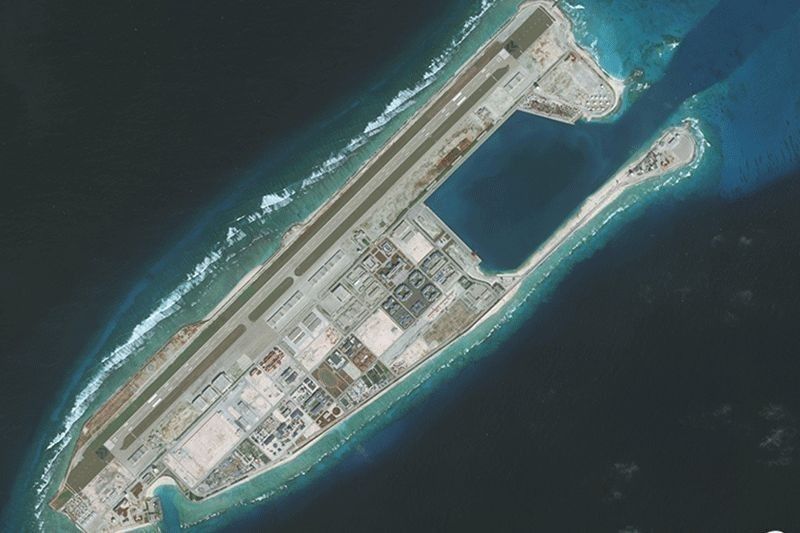Three-way maritime standoff emerging in Spratlys — think tank

MANILA, Philippines — A three-way maritime standoff among China, Malaysia and Vietnam is developing in the disputed Spratly islands in the South China Sea, a Washington-based think tank reported on Saturday.
The Center for Strategic and International Studies-Asia Maritime Transparency International (CSIS-AMTI), in its latest monitoring of the South China Sea dispute, said the developing standoff stemmed from Malaysia’s gas and oil exploration within its declared fields that sit on block ND1 and ND2 in the archipelago.
“A months-long standoff over oil and gas operations in the South China Sea is playing out between Malaysian, Chinese and a small number of Vietnamese vessels, though all three governments are keeping the episode out of the public eye,” AMTI said.
AMTI had been closely watching the developing standoff since late last year using the vessels’ Automatic Identification System (AIS) broadcasts, and through captured commercial satellite imagery.
Various Chinese Coast Guard vessels, a Malaysian patrol vessel and its missile firing ships, and two Vietnamese boats are now reportedly involved in the three-way standoff at the disputed archipelago.
While the area where the current developing tension is near the contested maritime boundaries of Malaysia and Vietnam, it is also within China’s uncharted nine-dash-line territorial and maritime claim that covers almost 90 percent of the South China Sea.
While the Philippines is not a party to the prevailing maritime dispute, the area of the mounting conflict is just south of Filipino outposts in the Kalayaan Island Group (KIG).
The Chinese vessels involved in the ongoing conflict with Malaysia and Vietnam, also came from Beijing’s key naval facilities sitting on artificial islands at Zamora (Subi), Panganiban (Mischief) and Kagitingan (Fiery Cross) reefs.
These three reefs are among the seven features within the Philippine-declared KIG that China occupied before transforming them into highly fortified military naval and air facilities.
“Data collected reveals a dangerous, ongoing game of chicken involving law enforcement, militia and civilian vessels,” AMTI said.
The heart of the standoff, it said, is the West Capella, a drillship operated by London-managed Seadrill and contracted to Malaysia’s Petronas.
West Capella began operating in oil and gas block ND4 off the coast of Malaysia’s Sabah State in October last year.
The following month, however, two Chinese Coast Guard (CCG) ships, the Zhaojun-Class 5202 and Zhaolai-Class 5043, taking time off from escorting a Chinese fishing fleet inside Indonesian maritime waters, started circling the oil rig.
Despite the Chinese CCG ships’ menacing presence, West Capella maintained its ongoing oil and gas exploration at ND1 before heading to ND2 Lala-1 oil and gas field on Dec. 1.
The area is already beyond Malaysia’s 200-nautical mile exclusive economic (EEZ) but is being claimed by Kuala Lumpur as part of its extended continental shelf.
“The CCG responded almost immediately. The 5202 detoured from its duties escorting Chinese fishing vessels in the area to circle West Capella. On Dec. 22, China dispatched the I from Hainan to Luconia Shoals, where Beijing maintains a near-constant presence off the coast of Malaysia’s Sarawak State. For the next two months, the Zhaojun-class 5203 split its time between harassing the London-managed oil rig,” AMTI reported.
On Dec. 26 to Dec. 27, CCG ship 5203 was monitored also patrolling the oil and gas block SK408, which is operated by Sapura Energy, with investments from Petronas and Sarawak Shell, before heading off to harass the West Capella on Jan. 3.
Another CCG vessel, the recently renamed Haijing 5305 (formerly 46303), as per AMTI’s tracking, made a detour to harass West Capella on Jan. 6 while en route to reinforce a Chinese fishing flotilla then operating in Indonesian waters.
“Satellite imagery also reveals what appear to be Vietnamese fishing vessels deployed around this time in the area of conflict to monitor the Malaysian operations in the joint Define Area,” AMTI said.
“As of publication, the standoff is ongoing. The West Capella and its offshore supply vessels continue to operate in block ND1. Vietnamese militia vessels remain on-station monitoring and likely demanding the oil and gas exploration to stop,” the AMTI said.
“The movitations of China and Vietnam seem clear. The biggest question is why the Malaysian government chose to ignore the spirit of the 2009 joint submission with Vietnam and, in so doing, undermine whatever solidarity Southeast Asian parties might hope to build in their oil and gas disputes with Beijing,” AMTI added.
- Latest
- Trending
































